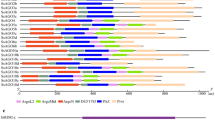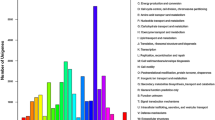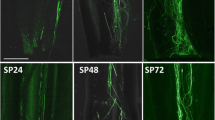Abstract
S-RNase-based self-incompatibility is found in Solanaceae, Rosaceae, and Scrophulariaceae, and is the most widespread mechanism that prevents self-fertilization in plants. Although ‘Shatian’ pummelo (Citrus grandis), a traditional cultivated variety, possesses the self-incompatible trait, the role of S-RNases in the self-incompatibility of ‘Shatian’ pummelo is poorly understood. To identify genes associated with self-incompatibility in citrus, we identified 16 genes encoding homologs of ribonucleases in the genomes of sweet orange (Citrus sinensis) and clementine mandarin (Citrus clementine). We preliminarily distinguished S-RNases from S-like RNases with a phylogenetic analysis that classified these homologs into three groups, which is consistent with the previous reports. Expression analysis provided evidence that CsRNS1 and CsRNS6 are S-like RNase genes. The expression level of CsRNS1 was increased during fruit development. The expression of CsRNS6 was increased during the formation of embryogenic callus. In contrast, we found that CsRNS3 possessed several common characteristics of the pistil determinant of self-incompatibility: it has an alkaline isoelectric point (pI), harbors only one intron, and is specifically expressed in style. We obtained a cDNA encoding CgRNS3 from ‘Shatian’ pummelo and found that it is homolog to CsRNS3 and that CgRNS3 exhibited the same expression pattern as CsRNS3. In an in vitro culture system, the CgRNS3 protein significantly inhibited the growth of self-pollen tubes from ‘Shatian’ pummelo, but after a heat treatment, this protein did not significantly inhibit the elongation of self- or non-self-pollen tubes. In conclusion, an S-RNase gene, CgRNS3, was obtained by searching the genomes of sweet orange and clementine for genes exhibiting sequence similarity to ribonucleases followed by expression analyses. Using this approach, we identified a protein that significantly inhibited the growth of self-pollen tubes, which is the defining property of an S-RNase.








Similar content being viewed by others
References
Ambrosio L, Morriss S, Riaz A, Bailey R, Ding J, MacIntosh GC (2014) Phylogenetic analyses and characterization of RNase X25 from Drosophila melanogaster suggest a conserved housekeeping role and additional functions for RNase T2 enzymes in protostomes. PLoS One 9:e105444
Anderson MA, Cornish EC, Mau SL, Williams EG, Hoggart R, Atkinson A, Bonig I, Grego B, Simpson R, Roche PJ, Haley JD, Penschow JD, Niall HD, Tregear GW, Coghlan JP, Crawford RJ, Clarke AE (1986) Cloning of cDNA for a stylar glycoprotein associated with expression of self incompatibility in Nicotiana alata. Nature 321:38–44
Asquini E, Gerdol M, Gasperini D, Igic B, Graziosi G, Pallavicini A (2011) S-RNase-like sequences in styles of Coffea (Rubiaceae). Evidence for S-RNase based gametophytic self-Incompatibility? Trop Plant Biol 4:237–249
Banović B, Šurbanovski N, Konstantinović M, Maksimović V (2009) Basic RNases of wild almond (Prunus webbii): cloning and characterization of six new S-RNase and one “non-S RNase” genes. J Plant Physiol 166:395–402
Bariola PA, Green PJ (1997) Plant ribonucleases. Ribonucleases: structures and functions. Academic Press, New York
Bredemeijer GMM, Blaas J (1981) S-specific proteins in styles of self-incompatible Nicotiana alata. Theor Appl Genet 59:185–190
Broothaerts W, Janssens GA, Proost P, Broekaert WF (1995) cDNA cloning and molecular analysis of two self-incompatibility alleles from apple. Plant Mol Biol 27:499–511
Cao H, Zhang J, Xu J, Ye J, Yun Z, Xu Q, Xu J, Deng X (2012) Comprehending crystalline β-carotene accumulation by comparing engineered cell models and the natural carotenoid-rich system of citrus. J Exp Bot 63:4403–4417
Caruso M, Merelo P, Distefano G, La Malfa S, Lo Piero AR, Tadeo FR, Talon M, Gentile A (2012) Comparative transcriptome analysis of stylar canal cells identifies novel candidate genes implicated in the self-incompatibility response of Citrus clementina. BMC Plant Biol 12:20
Chai L, Biswas MK, Ge X, Deng X (2010) Isolation, characterization, and expression analysis of an SKP1-like gene from ‘Shatian’ pummelo (Citrus grandis Osbeck). Plant Mol Biol Rep 28:569–577
Chai L, Ge X, Biswas MK, Deng X (2011a) Molecular analysis and expression of a floral organ-relative F-box gene isolated from ‘Zigui shatian’ pummelo (Citrus grandis Osbeck). Mol Biol Rep 38:4429–4436
Chai L, Ge X, Xu Q, Deng X (2011b) CgSL2, an S-like RNase gene in ‘Zigui shatian’ pummelo (Citrus grandis Osbeck), is involved in ovary senescence. Mol Biol Rep 38:1–8
Chalivendra SC, Lopez-Casado G, Kumar A, Kassenbrock AR, Royer S, Tovar-Mèndez A, Covey PA, Dempsey LA, Randle AM, Stack SM (2013) Developmental onset of reproductive barriers and associated proteome changes in stigma/styles of Solanum pennellii. J Exp Bot 64:265–279
Cui J, Wang H, Liu S, Zhu L, Qiu X, Jiang Z, Wang X, Liu Z (2014) SNP discovery from transcriptome of the Swimbladder of Takifugu rubripes. PLoS One 9:e92502
De Franceschi P, Dondini L, Sanzol J (2012) Molecular bases and evolutionary dynamics of self-incompatibility in the Pyrinae (Rosaceae). J Exp Bot 63:4015–4032
De Nettancourt D (2001) Incompatibility and incongruity in wild and cultivated plants. Springer-Verlag, Berlin
Deng X (1987) Studies on the isolation, regeneration and fusion of protoplast in Citrus. Dissertation, Huazhong Agriculture University
Deshpande RA, Shankar V (2002) Ribonucleases from T2 family. Crit Rev Microbiol 28:79–122
Gasteiger E, Hoogland C, Gattiker A, Wilkins MR, Appel RD, Bairoch A (2005) Protein identification and analysis tools on the ExPASy server. In Walker JM (ed) The Proteomics Protocols Handbook. Humana Press, pp 571–607
Gray JE, Mcclure BA, Bönig I, Anderson MA, Clarke AE (1991) Action of the style product of the self-incompatibility gene of Nicotiana alata (S-RNase) on in vitro-grown pollen tubes. Plant Cell 3:271–283
Guo A, Zhu Q, Chen X, Luo J (2007) GSDS: a gene structure display server. Yi Chuan 29:1023–1026
Hillwig MS, Rizhsky L, Wang Y, Umanskaya A, Essner JJ, MacIntosh GC (2009) Zebrafish RNase T2 genes and the evolution of secretory ribonucleases in animals. BMC Evol Biol 9:170
Hiratsuka S, Zhang SL, Nakagawa E, Kawai Y (2001) Selective inhibition of the growth of incompatible pollen tube by S-protein in the Japanese pear. Sex Plant Reprod 13:209–215
Hua ZH, Fields A, Kao Th (2008) Biochemical models for S-RNase-based self-incompatibility. Mol Plant 1:575–585
Huang S, Lee HS, Karunanandaa B, Kao TH (1994) Ribonuclease activity of Petunia inflata S proteins is essential for rejection of self-pollen. Plant Cell 6:1021–1028
Igic B, Kohn JR (2001) Evolutionary relationships among self-incompatibility RNases. Proc Natl Acad Sci USA 98:13167–13171
Irie M (1999) Structure-function relationships of acid ribonucleases: lysosomal, vacuolar, and periplasmic enzymes. Pharmacol Ther 81:77–89
Isaacson T, Damasceno CM, Saravanan RS, He Y, Catalá C, Saladié M, Rose JK (2006) Sample extraction techniques for enhanced proteomic analysis of plant tissues. Nat Protoc 1:769–774
Jahnen W, Lush WM, Clarke AE (1989) Inhibition of in vitro pollen tube growth by isolated S-glycoproteins of Nicotiana alata. Plant Cell 1:501–510
Kawata Y, Sakiyama F, Hayashi F, Kyogoku Y (1990) Identification of two essential histidine residues of ribonuclease T2 from Aspergillus oryzae. Eur J Biochem 187:255–262
Lee HS, Singh A, Kao T (1992) RNase X2, a pistil-specific ribonuclease from Petunia inflata, shares sequence similarity with solanaceous S proteins. Plant Mol Biol 20:1131–1141
Lee HS, Huang S, Kao TH (1994) S proteins control rejection of incompatible pollen in petunia inflata. Nature 367:560–563
Lescot M, Déhais P, Thijs G, Marchal K, Moreau Y, Van de Peer Y, Rouzé P, Rombauts S (2002) PlantCARE, a database of plant cis-acting regulatory elements and a portal to tools for in silico analysis of promoter sequences. Nucleic Acids Res 30:325–327
Li P, Miao HX, Ma YW, Wang L, Hu GB, Ye ZX, Zhao JT, Qin YH (2015) CrWSKP1, an SKP1-like Gene, is involved in the self-Incompatibility reaction of “Wuzishatangju” (Citrus reticulata Blanco). Int J Mol Sci 16:21695–21710
Li J, Zhang Y, Song Y, Zhang H, Fan J, Li Q, Zhang D, Xue Y (2016) Electrostatic potentials of the S-locus F-box proteins contribute to the pollen S specificity in self-incompatibility in Petunia hybrida. Plant J. doi:10.1111/tpj.13318
Liang LZ, Lai Z, Ma WS, Zhang YS, Xue YB (2002) AhSL28, a senescence-and phosphate starvation-induced S-like RNase gene in Antirrhinum. Biochim Biophys Acta 1579:64–71
Liang M, Yang X, Li H, Su S, Yi H, Chai L, Deng X (2015) De novo transcriptome assembly of pummelo and molecular marker development. PLoS ONE 10:e0120615
Lin Z, Eaves DJ, Sanchez Moran E, Franklin FCH, Franklin Tong VE (2015) The Papaver rhoeas S determinants confer self-incompatibility to Arabidopsis thaliana in planta. Science 350:684–687
Liu J, Deng X (2002) Regeneration and analysis of citrus interspecific mixoploid hybrid plants from asymmetric somatic hybridization. Euphytica 125:13–20
Liu Y, Liu Q (2006) Efficient isolation of RNA from fruit peel and pulp of ripening navel orange (Citrus sinensis Osbeck). Dissertation, Journal of Huazhong Agricultural University
Luhtala N, Parker R (2010) T2 Family ribonucleases: ancient enzymes with diverse roles. Trends Biochem Sci 35:253–259
Masashi Y, Tatsuya K, Shigeto T (2006) Self-and cross-incompatibility of various citrus accessions. J Jpn Soc Hortic Sci 75:372–378
McClure BA, Haring V, Ebert PR, Anderson MA, Simpson RJ, Sakiyama F, Clarke AE (1989) Style self-incompatibility gene products of Nicotlana alata are ribonucleases. Nature 342:955–957
McCubbin AG, Kao Th (2000) Molecular recognition and response in pollen and pistil interactions. Annu Rev Cell Dev Biol 16:333–364
Meng D, Gu Z, Yuan H, Wang A, Li W, Yang Q, Zhu Y, Li T (2014) The microtubule cytoskeleton and pollen tube Golgi vesicle system are required for in vitro S-RNase internalization and gametic self-incompatibility in apple. Plant Cell Physiol 55:977–989
Miao HX, Qin YH, da Silva JAT, Ye ZX, Hu GB (2011) Cloning and expression analysis of S-RNase homologous gene in Citrus reticulata Blanco cv. Wuzishatangju. Plant Sci 180:358–367
Miao HX, Ye ZX, Qin YH, Hu GB (2013) Molecular characterization and expression analysis of S1 self-incompatibility locus-linked pollen 3.15 gene in Citrus reticulata. J Integr Plant Biol 55:443–452
Miao HX, Ye ZX, Hu GB, Qin YH (2015) Comparative transcript profiling of gene expression between self-incompatible and self-compatible mandarins by suppression subtractive hybridization and cDNA microarray. Mol Breed 35:1–15
Murfett J, Atherton TL, Mou B, Gassert CS, Mcclure BA (1994) S-RNase expressed in transgenic Nicotiana causes S-allele-specific pollen rejection. Nature 367:563–566
Ngo B (2001) Study on the self-incompatibility in Citrus (Rutaceae) with special emphases on the pollen tube growth and allelic variation. Dissertation, Kyushu University
Nishimura E, Jumyo S, Arai N, Kanna K, Kume M, J-i Nishikawa, J-i Tanase, Ohyama T (2014) Structural and functional characteristics of S-like ribonucleases from carnivorous plants. Planta 240:147–159
Ohno H, Ehara Y (2005) Expression of ribonuclease gene in mechanically injured or virus-inoculated Nicotiana tabacum leaves. Tohoku J Agric Res 55:99–109
Pan Z, Liu Q, Yun Z, Guan R, Zeng W, Xu Q, Deng X (2009) Comparative proteomics of a lycopene-accumulating mutant reveals the important role of oxidative stress on carotenogenesis in sweet orange (Citrus sinensis [L.] osbeck). Proteomics 9:5455–5470
Perez-Amador MA, Leon J, Green PJ, Carbonell J (2002) Induction of the arginine decarboxylase ADC2 gene provides evidence for the involvement of polyamines in the wound response in Arabidopsis. Plant Physiol 130:1454–1463
Roalson EH, McCubbin AG (2003) S-RNases and sexual incompatibility: structure, functions, and evolutionary perspectives. Mol Phylogenet Evol 29:490–506
Salekdeh GH, Siopongco J, Wade L, Ghareyazie B, Bennett J (2002) A proteomic approach to analyzing drought-and salt-responsiveness in rice. Field Crops Research 76:199–219
Sassa H, Hirano H, Ikehashi H (1992) Self-incompatibility-related RNases in styles of Japanese pear (Pyrus serotina Rehd.). Plant Cell Physiol 33:811–814
Sassa H, Hirano H, Ikehashi H (1993) Identification and characterization of stylar glycoproteins associated with self-incompatibility genes of Japanese pear, Pyrus serotina Rehd. Mol Gen Genet 241:17–25
Schommer C, Palatnik JF, Aggarwal P, Chételat A, Cubas P, Farmer EE, Nath U, Weigel D (2008) Control of jasmonate biosynthesis and senescence by miR319 targets. PLoS Biol 6:e230
Takayama S, Isogai A (2005) Self-incompatibility in plants. Ann Rev Plant Biol 56:467–489
Tamura K, Peterson D, Peterson N, Stecher G, Nei M, Kumar S (2011) MEGA5: molecular evolutionary genetics analysis using maximum likelihood, evolutionary distance, and maximum parsimony methods. Mol Biol Evol 28:2731–2739
Tao R, Yamane H, Sassa H, Mori H, Gradziel TM, Dandekar AM, Sugiura A (1997) Identification of stylar RNases associated with gametophytic self-incompatibility in Almond (Prunus dulcis). Plant Cell Physiol 38:304–311
Tao R, Yamane H, Sugiura A, Murayama H, Sassa H, Mori H (1999) Molecular typing of S-alleles through identification, characterization and cDNA cloning for S-RNases in sweet cherry. J Am Soc Hortic Sci 124:224–233
Taylor CB, Bariola PA, Raines RT, Green PJ (1993) RNS2: a senescence-associated RNase of Arabidopsis that diverged from the S-RNases before speciation. Proc Natl Acad Sci USA 90:5118–5122
Uchida A, Takenaka S, Sakakibara Y, Kurogi S, Honsho C, Sassa H, Suiko M, Kunitake H (2012) Comprehensive analysis of expressed proteins in the different stages of the style development of self-incompatible ‘Hyuganatsu’ (Citrus tamurana hort. ex Tanaka). J Jpn Soc Hortic Sci 81:150–158
Velasco R, Licciardello C (2014) A genealogy of the citrus family. Nat Biotechnol 32:640–642
Wang CL, Xu GH, Jiang XT, Chen G, Wu J, Wu HQ, Zhang SL (2009) S-RNase triggers mitochondrial alteration and DNA degradation in the incompatible pollen tube of Pyrus pyrifolia in vitro. Plant J 57:220–229
Waugh DS (2005) Making the most of affinity tags. Trends Biotechnol 23:316–320
Wei JY, Li AM, Li Y, Wang J, Liu XB, Liu LS, Xu ZF (2006) Cloning and characterization of an RNase-related protein gene preferentially expressed in rice stems. Biosci Biotechnol Biochem 70:1041–1045
Woo HR, Chung KM, Park JH, Oh SA, Ahn T, Hong SH, Jang SK, Nam HG (2001) ORE9, an F-box protein that regulates leaf senescence in Arabidopsis. Plant Cell 13:1779–1790
Wu J, Gu C, Khan MA, Wu J, Gao Y, Wang C, Korban SS, Zhang S (2013) Molecular determinants and mechanisms of gametophytic self-Incompatibility in fruit trees of Rosaceae. Crit Rev Plant Sci 32:53–68
Wu GA, Prochnik S, Jenkins J, Salse J, Hellsten U, Murat F, Perrier X, Ruiz M, Scalabrin S, Terol J (2014a) Sequencing of diverse mandarin, pummelo and orange genomes reveals complex history of admixture during citrus domestication. Nat Biotechnol 32:656
Wu J, Xu Z, Zhang Y, Chai L, Yi H, Deng X (2014b) An integrative analysis of the transcriptome and proteome of the pulp of a spontaneous late-ripening sweet orange mutant and its wild type improves our understanding of fruit ripening in citrus. J Exp Bot 65:1651–1671
Xu Q, Chen LL, Ruan X, Chen D, Zhu A, Chen C, Bertrand D, Jiao W-B, Hao B-H, Lyon MP (2013) The draft genome of sweet orange (Citrus sinensis). Nat Genet 45:59–66
Yoo SD, Cho YH, Sheen J (2007) Arabidopsis mesophyll protoplasts: a versatile cell system for transient gene expression analysis. Nat Protoc 2:1565–1572
Zhang SW, Ding F, He XH, Luo C, Huang GX, Hu Y (2015) Characterization of the ‘Xiangshui’ lemon transcriptome by de novo assembly to discover genes associated with self-incompatibility. Mol Genet Genomics 290:365–375
Acknowledgements
This research was financially supported by the National Natural Science Foundation of China (Nos. 31301760, 31521092, 31460507), the Special Fund for Agro-scientific Research in the Public Interest (201303093), and Scientific Research and Technology Development Program of Guangxi (Gui Ke He1599005-2-15). We also thank Prof. Zuoxiong Liu and Prof. Robert M. Larkin for help with English language editing.
Author information
Authors and Affiliations
Corresponding author
Ethics declarations
Conflict of interest
The authors declare that none of the authors have a conflict of interest and that this article does not contain any studies with human participants or animals.
Additional information
Communicated by S. Hohmann.
Electronic supplementary material
Below is the link to the electronic supplementary material.
Rights and permissions
About this article
Cite this article
Liang, M., Yang, W., Su, S. et al. Genome-wide identification and functional analysis of S-RNase involved in the self-incompatibility of citrus. Mol Genet Genomics 292, 325–341 (2017). https://doi.org/10.1007/s00438-016-1279-8
Received:
Accepted:
Published:
Issue Date:
DOI: https://doi.org/10.1007/s00438-016-1279-8




